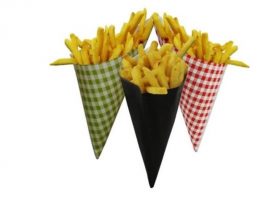This is the third in my series of stories from our recent two-week trip to Europe. You’ll find other entries here.
Remember in 2003, when the French wouldn’t let us fly our military jets over their country on the way to war in Iraq, so the idiotic members of Congress renamed the French Fries in the Capitol cafeteria “Freedom Fries”? As many of us pointed out at the time, fries weren’t even invented in France. They originally came from Belgium, a fact that country is still quite proud of.
In fact, in Brussels, you can’t go a block without seeing a food place advertising its fries — sometimes the only item on their menu! — which they sell in paper cones you take with you. In Bruges, there’s even a Frietmuseum, dedicated to the history of potatoes and their immersion in hot oil.
However, if you want ketchup to dunk those fries in, you’ll have to pay an extra 50 cents. Same for mayonnaise — the local favorite — or mustard or any other “sauce” you’d like. You also have to pay for drinking water. There’s no such thing as a free glass of tap water. You’re gonna have to cough up for a bottle or two. And it’s not going to be cold.
I don’t know why, but Europeans seem to prefer room-temperature beverages. Each time Martha or I asked for a glass of ice they looked at us as if we’d requested a moldy brick omelet. It’s not that they don’t have ice — they always brought it to us, but in tiny glasses in which you’d usually be served an amaretto sour. There were no big glasses of cold beverages anywhere, regardless of how thirsty you might be.
The other bit of culinary genius Belgians are quite proud of is the waffle. The difference between theirs and ours is American waffles are almost purely associated with breakfast and maple syrups, while Belgian waffles are eaten as a snack or dessert treat (a la ice cream, with all sorts of toppings), purchased from stands that sell them to go. They are to Belgium what gelato is to Italy.
Belgium also has the absolute best chocolate I’ve ever had, with plenty of places to buy it, too.
In Copenhagen, every traditional restaurant’s menu starts with three standard items: herring, herring, and pickled herring. We don’t eat fish, so we mostly stayed away from any of those places, although we did have lunch at the oldest tavern in the city, Det Lille Apotek, which dates back to 1620. We’d previously eaten at an even older place in Bruges, Cafe Vlissinghe, which has been in business for over five centuries!
The two best meals we had in Europe did not involve local cuisine, but rather Chinese food.
One was at Au Bon Bol, a small place in Brussels tourists don’t go to, favored instead by young Belgians (we were easily the oldest people there). We were drawn to it after looking through the front window and seeing the woman who owns the restaurant pulling noodles. She does that all day long, so the noodles are really fresh when consumed in the big bowls of soup that are meals unto themselves. I felt sorry for the young waitress who delivered the steaming soup to tables. She looked as undone as Melanie Griffith serving dim sum at Sigourney Weaver’s party in “Working Girl.”
The other was a Mandarin place in Amsterdam’s Chinatown called New King. Unlike its neighbors, it had a line out the door, but the wait for a table was only about 15 minutes. The meal — which began with wonton soup for Martha and shrimp dumpling soup for me, followed by a special noodle dish with roast pork — was fantastic, well worth the time and money.
We discovered other wonderful foods in Amsterdam: small pancakes with powdered sugar and butter (poffertjes); cookies made of very thin waffles held together by a caramel interior (stroopwaffels), a pub food of fried balls of dough with a cheese-and-meat mixture inside (bitterballen, reminiscent of suppli in Italy), and a plateful of sausage or hamburger with a sort of potato hash (hutspot).
But our favorite was the apple pie at a place called Winkel 43. After just one bite, I was quoting the alien-in-human-form in “Starman” played by Jeff Bridges: “Dutch apple pie! It’s terrific!!”
All of these were introduced to us on a walking food tour led by a young British woman named Charlie, who moved to the Netherlands earlier this year so her clothing accessories business won’t be negatively impacted by the Brexit disaster. We did two other food tours, one in Brussels led by Ricardo, a Portuguese ex-pat who has lived there for several years, and one in Paris led by Nick, whose family has lived in the neighborhood we toured for generations. Ironically, it was the first two tours — the ones led by the immigrants — that we enjoyed more.
You may have noticed that I haven’t mentioned having any outstanding meals in Paris, despite spending three days there. That’s because we didn’t have anything particularly memorable, even on Nick’s tour through the Marche d’Alligre marketplace. Yes, there were all sorts of fruits and meats and cheeses, but he didn’t show us anything all that compelling. We did learn that we don’t like gooseberries (too bitter) and that the local bakeries make baguettes several times a day, so they’re always fresh, and — as if we didn’t know — the French really enjoy wine. But that was about it.
We had two dinners at local places near our Parisian hotel, neither of which left an overwhelmingly positive impression, but Martha did have a great bowl of French onion soup for lunch at La Tamine on Rue de Rivoli. In France, of course, it’s known merely as “onion soup” — whereas, on Capitol Hill, Republicans refer to it as “freedom broth.”
You’ll find other entries in this series here.

